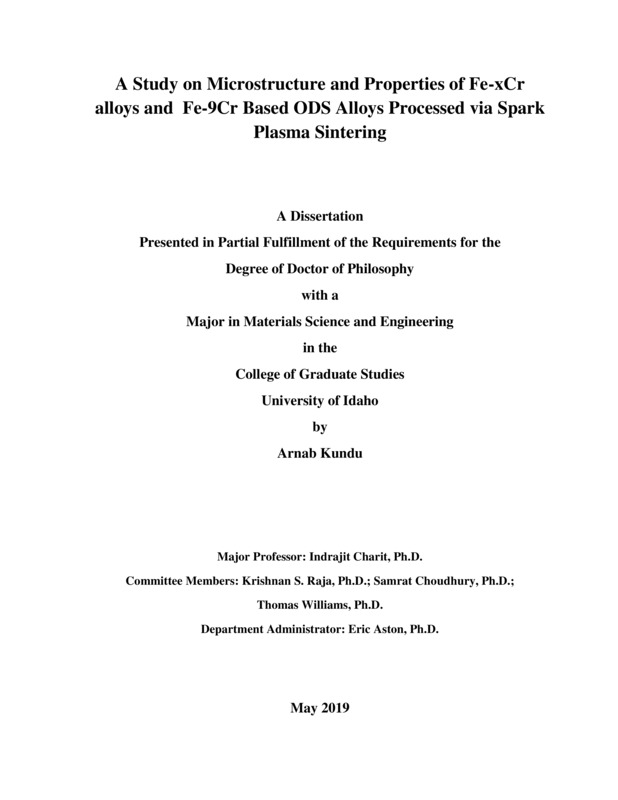A Study on Microstructure and Properties of Fe-xCr alloys and Fe-9Cr Based ODS Alloys Processed via Spark Plasma Sintering
Kundu, Arnab. (2019-05). A Study on Microstructure and Properties of Fe-xCr alloys and Fe-9Cr Based ODS Alloys Processed via Spark Plasma Sintering. Theses and Dissertations Collection, University of Idaho Library Digital Collections. https://www.lib.uidaho.edu/digital/etd/items/kundu_idaho_0089e_11561.html
- Title:
- A Study on Microstructure and Properties of Fe-xCr alloys and Fe-9Cr Based ODS Alloys Processed via Spark Plasma Sintering
- Author:
- Kundu, Arnab
- Date:
- 2019-05
- Program:
- Chemical and Materials Science Engineering
- Subject Category:
- Materials Science
- Abstract:
-
Fe-Cr based oxide dispersion strengthened (ODS) alloys are potential candidates for usage as nuclear fuel cladding material for the upcoming Generation-IV nuclear reactor, especially in liquid sodium cooled fast reactors. These high performance materials have many advantages since they possess remarkable mechanical strength at high temperature and outstanding irradiation resistance. Particularly, ODS steels known as nanostructured ferritic alloys have negligible swelling under irradiation, and equally excellent creep properties because of nano-reinforcements i.e. the nanometric oxides present in the matrix. Traditionally, ODS processing combines mechanical alloying (MA) followed by hot consolidation via hot extrusion and hot isostatic pressing. In the present study, the ODS alloys are produced by a combined route of MA and Spark Plasma Sintering (SPS). After consolidation, the effects of processing parameters including milling parameters and sintering parameters, on the microstructure characteristics and mechanical properties of the milled powder and consolidated alloys are investigated. Once the suitable parameters are decided for the maximum compaction state for Fe-9Cr alloy, Fe-Cr alloys were produced with varying Cr content to understand the effect of Cr on the process of MA and SPS. Secondly, the effect of bimodal distribution obtained by various MA time has been observed after consolidation process. Finally, having understood the basic fundamentals of processing of Fe-Cr alloys, Fe-9Cr ODS was produced with addition of W and Ti and oxide particles as dispersoid phase. During the process of MA, the oxides get dissolved in the matrix and during consolidation process these oxides get precipitated as nanophases in the matrix thus resulting in the higher strength. In general, yttria (Y2O3) has been used as the oxide which is added to the Fe-Cr alloy system. Recently some work has been done on the addition of lanthana (La2O3). In this study, we have introduced a new oxide (CeO2) in the same amount (wt%) compared to Y2O3 and La2O3 to understand the effect of CeO2 on the ODS alloy. Powder and consolidated alloys characterization were performed using Scanning electron microscopy (SEM), Electron backscatter diffraction (EBSD) and Transmission electron microscopy (TEM). The mechanical properties were evaluated using microhardness testing and mini-compression testing. Corrosion tests were conducted at room temperature in various to understand the nature of the oxide layer formed on the Fe-Cr and Fe-9Cr ODS materials. Mechanical alloying created high density of dislocations, vacancies in the powder and facilitated the nucleation of NCs. It resulted in faster densification behavior by initiating sintering at lower temperatures by lowering the activation energy for both grain boundary and volume diffusion. Maximum densification (around 98%) occurred at temperatures 1000 oC for a sintering time of 45 min at 80 MPa pressure for 10 hr ball milled powder. Due to the combined strengthening mechanisms of work hardening, grain refinement, dispersion strengthening and solid solution strengthening, superior strength was achieved for the materials. On addition of alloying elements and the rare earth oxides, the presence of second phase particles like Cr0.875Ti0.125 is observed along with Ti-Cr-O-RE type precipitates which imparts high strength to the matrix both at room temperature an at elevated temperatures.
- Description:
- doctoral, Ph.D., Chemical and Materials Science Engineering -- University of Idaho - College of Graduate Studies, 2019-05
- Major Professor:
- Charit, Indrajit
- Committee:
- Raja, Krishnan S; Choudhury, Samrat; Williams, Thomas
- Defense Date:
- 2019-05
- Identifier:
- Kundu_idaho_0089E_11561
- Type:
- Text
- Format Original:
- Format:
- application/pdf
- Rights:
- In Copyright - Educational Use Permitted. For more information, please contact University of Idaho Library Special Collections and Archives Department at libspec@uidaho.edu.
- Standardized Rights:
- http://rightsstatements.org/vocab/InC-EDU/1.0/

